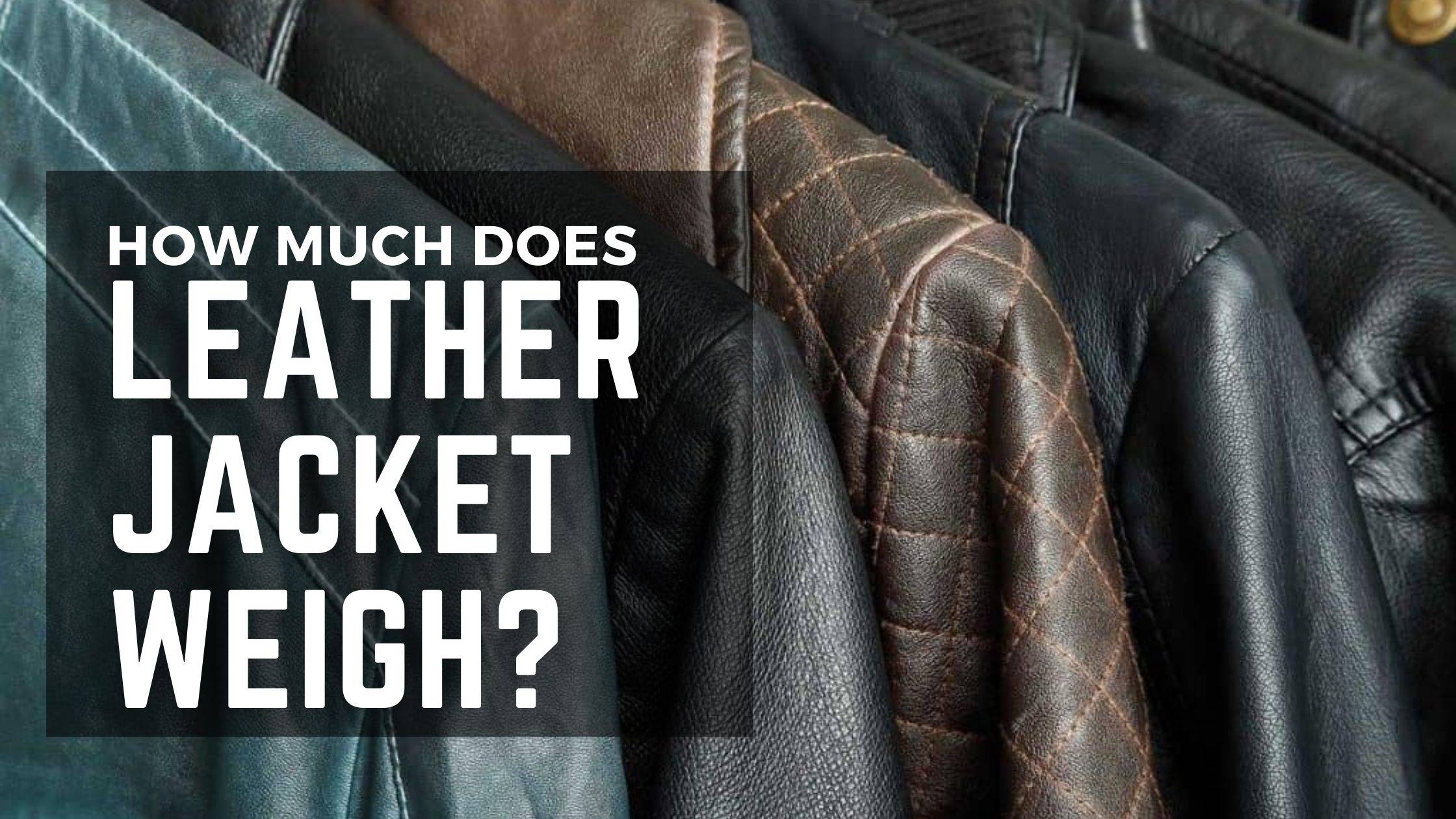Leather jackets are a timeless staple in wardrobes worldwide, offering both style and practicality. But have you ever wondered how much these iconic pieces weigh? We explored the scale to determine the weight of various leather jackets and their variations.
Let’s dive into the factors that affect the weight of a leather jacket and what you should consider when choosing one.
What Affects the Weight of a Leather Jacket?
Traditional Collection of leather jackets usually weigh between three to four pounds. However, several factors can influence this weight:

- Men’s vs. Women’s Jackets: Men’s jackets tend to be larger and heavier compared to women’s jackets due to differences in design and sizing.
- Length of the Leather Jacket: Longer jackets, such as trench coats, weigh more than shorter ones like biker jackets due to the additional material used.
- Presence of a Liner: Jackets with a liner are heavier. Liners add an extra layer for warmth and protection, contributing to the overall weight.
- Styles Of Leather Jackets: The style of the leather jacket can affect its weight. Classic leather jackets, vintage leather jackets, and trench coats are often heavier due to their design and additional features. On the other hand, sport-cut leather jackets and simple leather jackets tend to be lighter and more streamlined.
- Leather Types: The type of leather used significantly influences the jacket’s weight. Real leather jackets, such as those made from full-grain or genuine leather, tend to be heavier due to their dense and durable nature. Deerskin leather is another popular choice known for its softness and durability, but it can be on the heavier side compared to lighter options like faux leather.
- Leather Quality and Thickness: The quality and thickness of the leather also play a crucial role. High-quality leather jackets, particularly those with a thickness of around 1.3-1.4mm, offer excellent durability and protection but come with added weight. Thicker leather provides extra warmth and is more hard-wearing, making it suitable for colder climates and rough use.
- Thicker Leather vs. Light Leather: Differences in Weight: When it comes to leather jackets, the thickness of the leather plays a crucial role in determining the weight and overall feel of the jacket. Let’s break down the differences between thicker and lighter leather:
- Usage and Additional Features Leather jackets designed for specific purposes, like motorcycle jackets, often include extra features such as liners, shoulder armor, and rib stretch panels, which add to the weight. Jackets with perforated leather or liners might be lighter and more breathable, suitable for everyday wear and warmer climates.
Thicker Leather vs. Light Leather: Differences in Weight
When it comes to leather jackets, the thickness of the leather plays a crucial role in determining the weight and overall feel of the jacket. Let’s break down the differences between thicker and lighter leather:
Characteristics of Thicker Leather
- Heavyweight: Thicker leather is denser and thus heavier. Jackets made from thicker leather typically weigh more, providing a substantial feel.
- Durability: Thicker leather is more durable and resistant to wear and tear. It can withstand rough usage and harsh weather conditions, making it ideal for motorcycle jackets and other heavy-duty applications.
- Warmth: Due to its density, thicker leather offers better insulation, providing extra warmth in colder climates.
- Protection: Offers more protection against abrasions and impacts, which is why it’s often used in protective gear for bikers.
Examples:
- Full-Grain Leather: The top layer of the hide, known for its strength and durability.
- 1.3-1.4mm Waterproof Leather: A specific thickness that offers excellent protection and durability.
Characteristics of Light Leather
- Lightweight: Lighter leather is less dense, making the jacket feel more comfortable and easier to wear for extended periods.
- Flexibility: Light leather is generally more flexible and easier to move in, offering greater comfort for everyday wear.
- Breathability: Tends to be more breathable than thicker leather, making it suitable for warmer climates or indoor use.
- Fashionable: Often used in fashion-forward designs, light leather jackets can be stylish while still offering some degree of durability and protection.
Examples:
- Faux Leather: A synthetic alternative that is lighter in weight and often used in fashion jackets.
- Perforated Leather: Leather with small holes that enhance breathability and reduce weight.
Choosing Between Thicker and Light Leather
Purpose and Usage:
- If you need a jacket for heavy-duty use, such as riding a motorcycle or braving harsh weather, a thicker leather jacket is the way to go.
- For casual, everyday wear, a lighter leather jacket offers comfort and flexibility without the extra bulk.
Climate Considerations:
- Thicker leather is better suited for colder climates where additional warmth is necessary.
- Lighter leather is ideal for milder climates and can be layered with other clothing if needed.
Style Preferences:
- Thicker leather jackets often have a more rugged and classic look, suitable for vintage styles.
- Light leather jackets can be sleek and modern, fitting well with contemporary fashion trends.
Understanding the differences between thicker and light leather helps you choose the right jacket by balancing weight, durability, warmth, and style.
By considering these factors, you can make a well-informed decision when selecting the perfect leather jacket. Whether you prioritize style, comfort, or protection, knowing what affects a jacket’s weight will guide you to find the ideal balance.
Depending on your choices in the above options, you may know how much the desired coat will fit.
We know that this amount of information can save you even without a new coat! Continue reading below to learn exactly what goes into the pounds that a new leather jacket might add to your style.
Specific Leather Jacket Examples
Harley-Davidson Victory Sweep Leather Jacket: This iconic motorcycle jacket is a prime example of a high-quality, heavy leather jacket. It offers ample protection and durability, making it a favorite among motorcyclists.
Race-Ready Leather Jackets: These jackets are designed for performance and safety, balancing weight with protection. They typically include reinforced areas and armor, adding to the overall heft.
Practical Considerations
1. Everyday Wear
For everyday outfits, you’ll want a balance between weight and comfort. A normal leather jacket or a fashion leather jacket made from lighter materials might be the best choice for daily use. Consider a simple leather jacket or a stylish leather jacket that doesn’t sacrifice comfort for style.
2. Weather and Temperature
If you live in a colder climate, a heavier jacket with extra warmth might be necessary. However, for warmer areas, lightweight coat options or jackets with perforated panels for breathability are ideal. Finding the right balance between warmth and weight is key.
3. Personal Preference
Ultimately, the weight of your leather jacket comes down to personal preference. Some people prefer the substantial feel of a heavier, high-quality leather jacket, while others opt for lighter, more fashion-forward pieces. Consider your needs and lifestyle when choosing.
The weight of a leather jacket varies based on several factors, including the type of leather, its quality and thickness, the jacket’s style, and any additional features. Whether you’re looking for a classic brown leather jacket, a vintage piece, or a race-ready motorcycle jacket, there’s a perfect leather jacket out there for everyone.
So, next time you’re shopping for a leather jacket, keep these factors in mind. And remember, a well-chosen leather jacket can be a versatile and stylish addition to your wardrobe, providing both comfort and protection for years to come. Happy jacket hunting!
People Also Ask
What is the ideal thickness for a leather flight jacket?
The ideal thickness for a leather flight jacket is between 1.1mm to 1.3mm. This range offers a perfect balance of durability, flexibility, and comfort, providing adequate protection and insulation without being too heavy. Opting for this thickness ensures you get a practical, comfortable, and historically accurate jacket.
How much does a leather jacket weigh in kg/grams/ounces?
In Kilograms: A typical leather jacket weighs between 1.36 kg to 1.81 kg.
In Grams: A typical leather jacket weighs between 1,360 grams to 1,810 grams.
In Ounces: A typical leather jacket weighs between 48 ounces to 64 ounces.
Why is leather so heavy
The heaviest type of leather is typically full-grain leather. Full-grain leather is the top layer of the hide and includes all of the natural grain, making it the thickest and most durable. Among full-grain leathers, buffalo and cowhide leather are often the heaviest due to their dense and sturdy nature. Additionally, deerskin and kangaroo leather can also be quite heavy, though they are often prized for their softness and flexibility as well as their weight. The specific weight can vary, but these types of leather are generally thicker and heavier than other types, providing maximum durability and protection.

